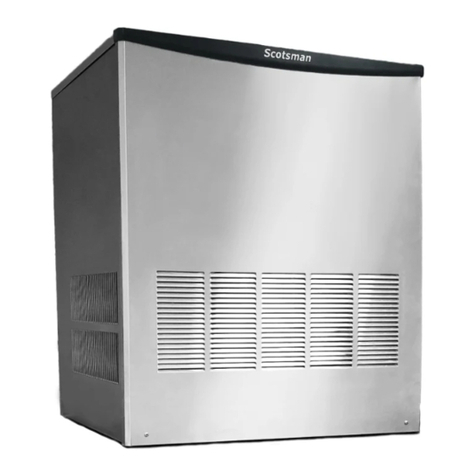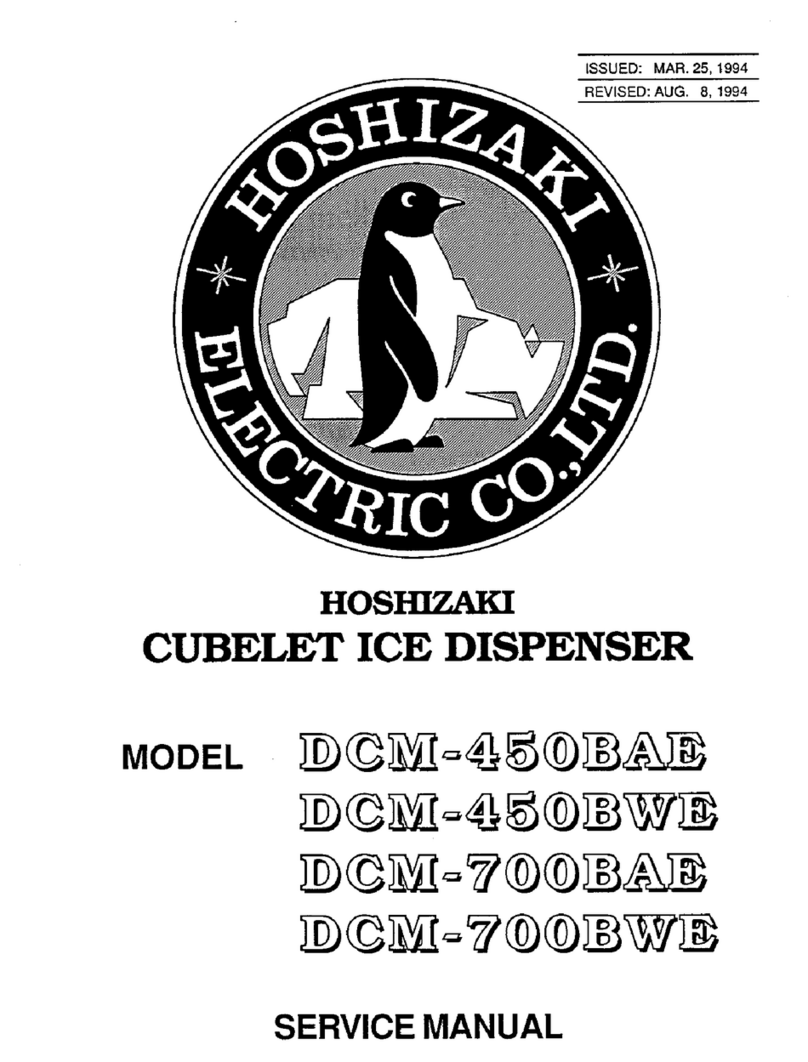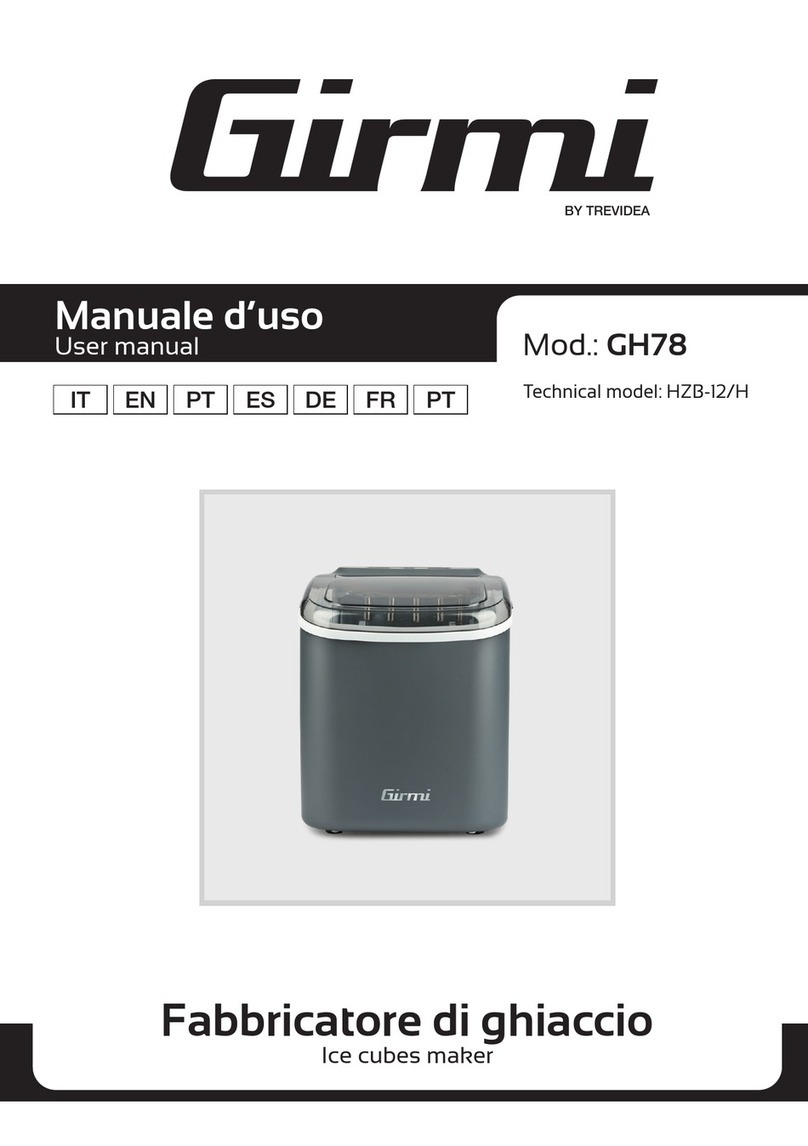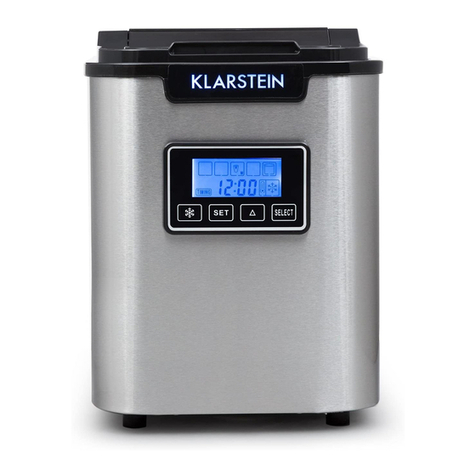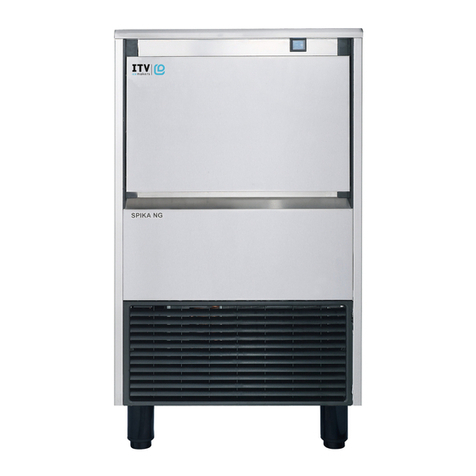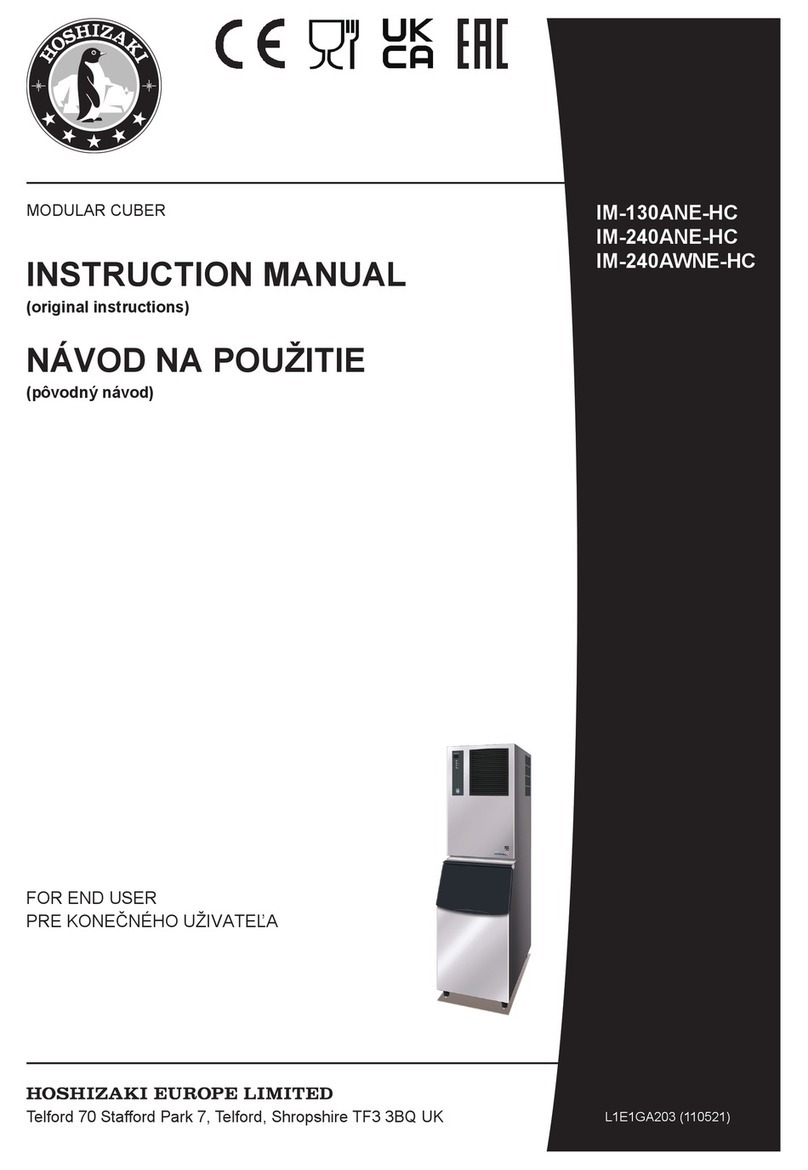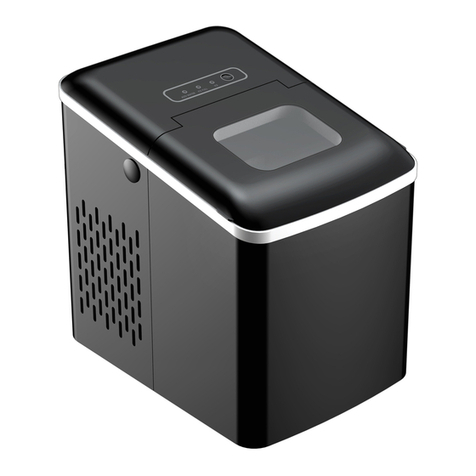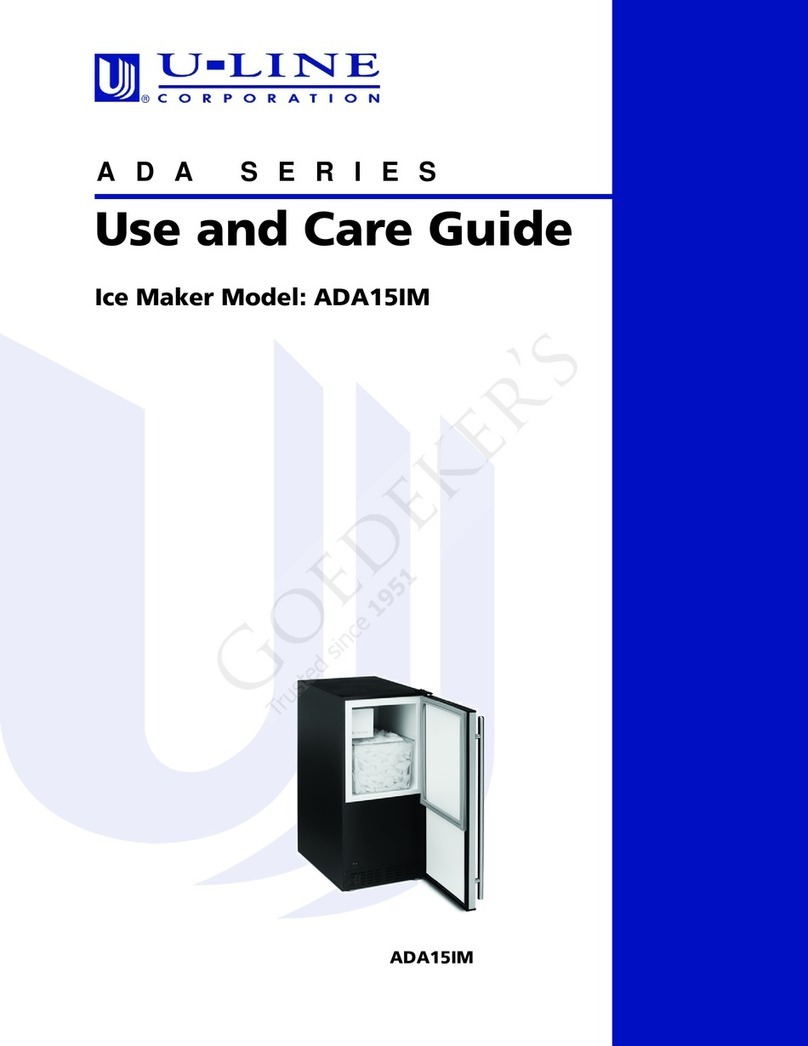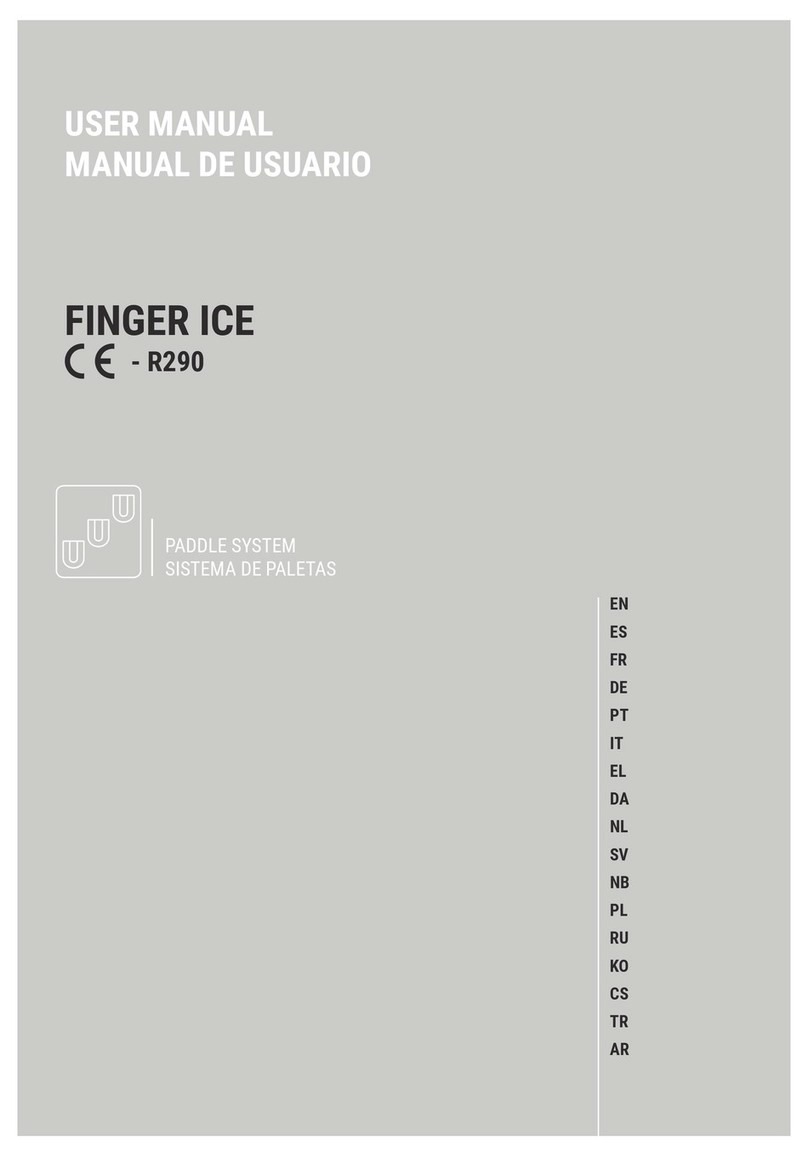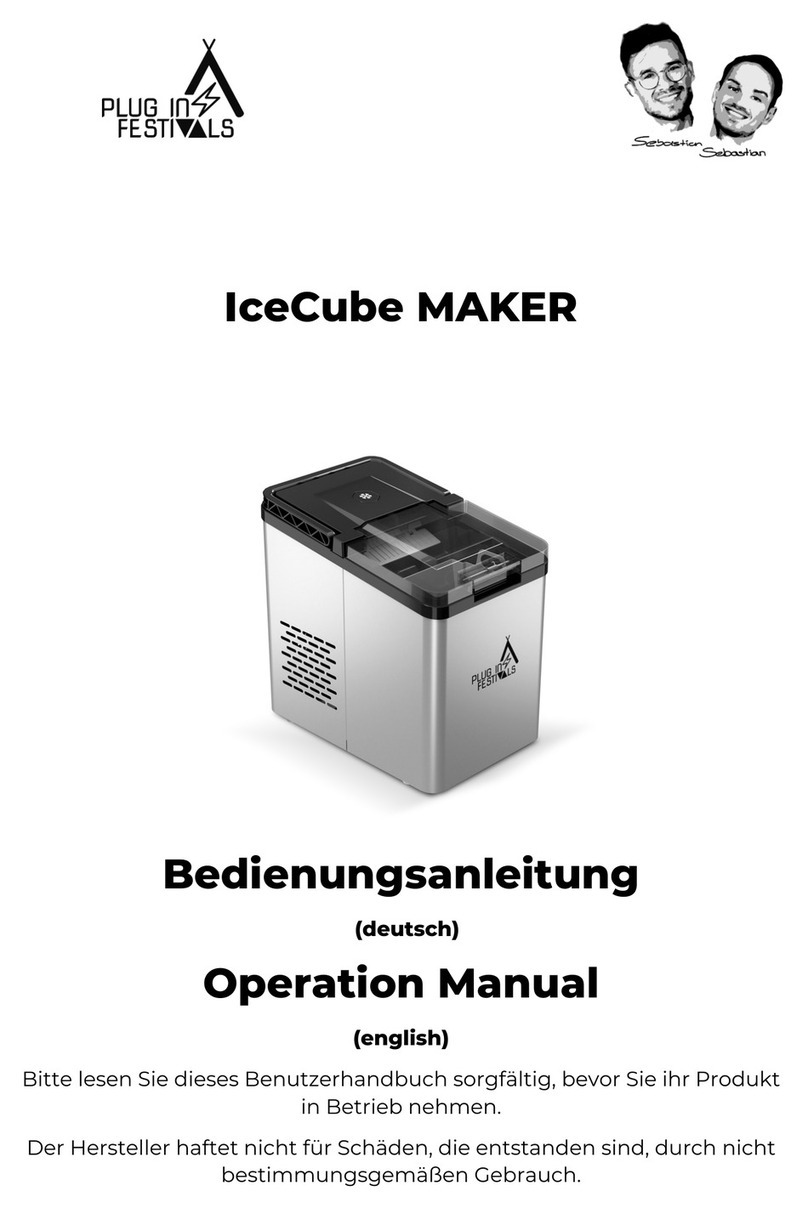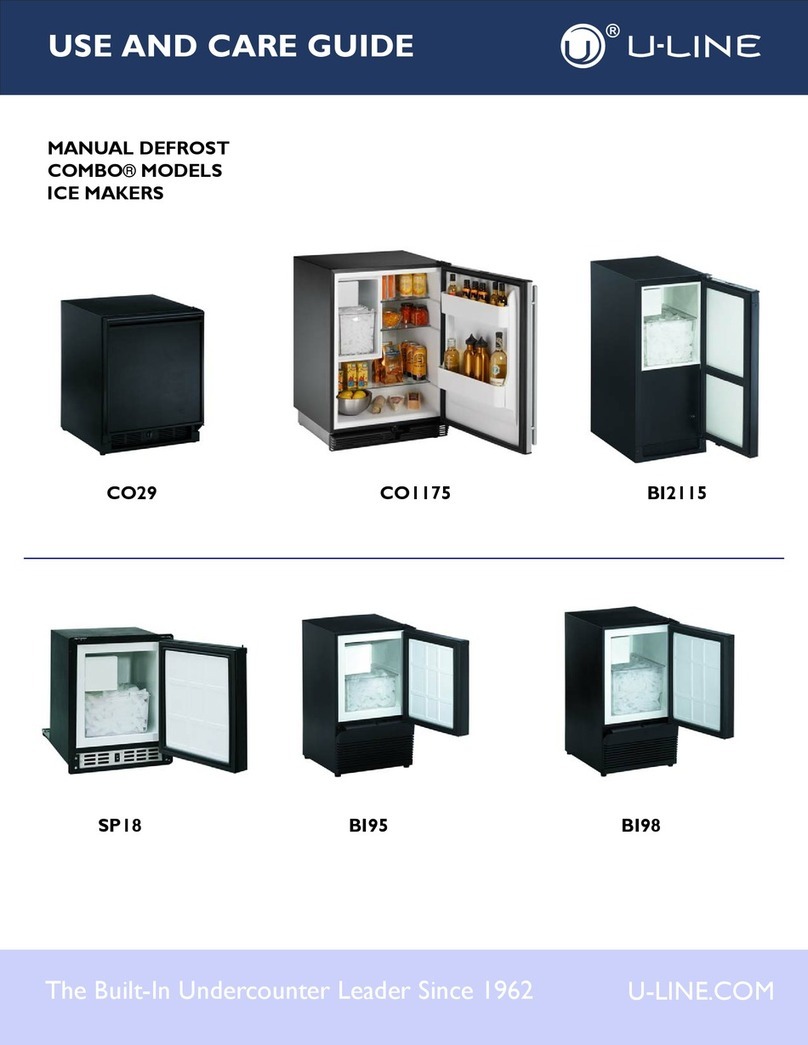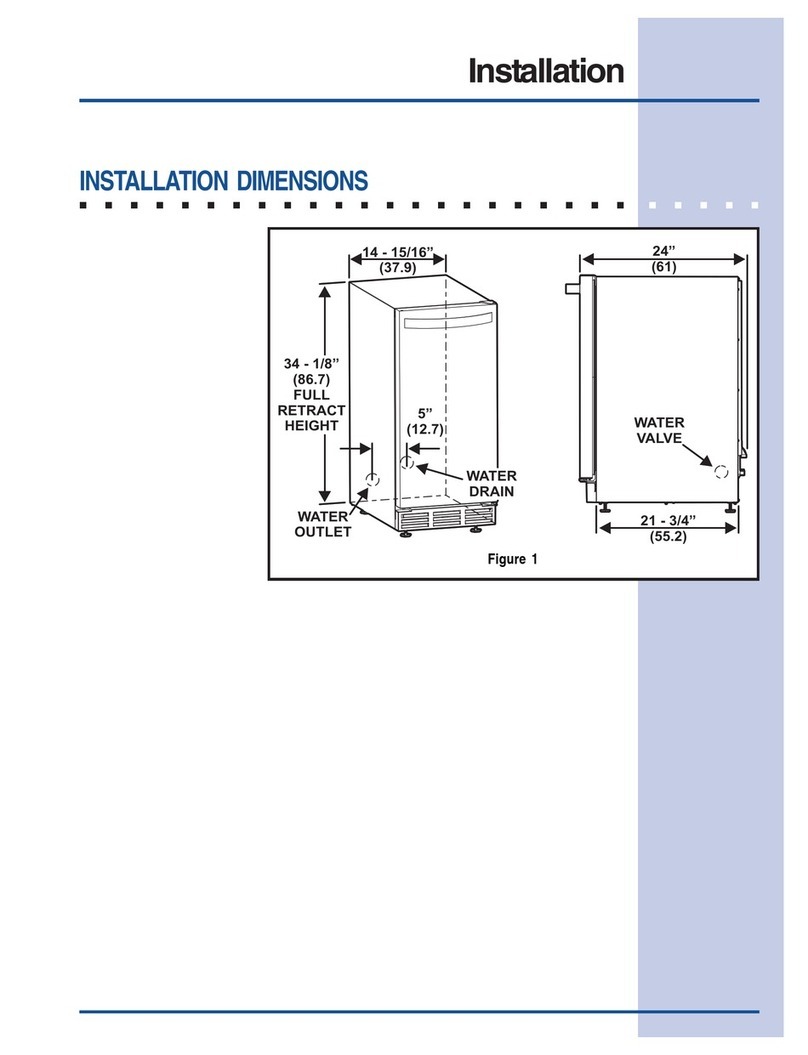Grafen CS20 A User manual

ICE CUBE MACHINES SERIES CS
KOSTKARKI DO LODU SERIA CS
USER MANUAL
INSTRUKCJA OBSŁUGI
You should read this user manual carefully before using
the appliance
Przed uruchomieniem urządzenia należy koniecznie
dokładnie przeczytać niniejszą instrukcję obsługi
Item: CS20 A
CS25 A
CS30 A
CS40 A
CS50 A
CS70 A
CS90 A
CS20 W
CS25 W
CS30 W
CS40 W
CS50 W
CS70 W
CS90 W

CONTENTS
1. SAFETY REGULATIONS ...........................................4
2. FOREWORD .............................................................7
3. OPERATION .............................................................7
4. ACTIVATING THE MACHINE..................................... 9
5. MALFUNCTION...................................................... 10
6. CLEANING AND MAINTENANCE........................... 11
Keep this manual with the appliance.
Zachowaj instrukcję urządzenia.
For indoor use only.
Do użytku wewnątrz pomieszczeń.

3
EN
NOTE: all devices that require a steady connection to water mains (including this device) must be connected
to a water softener which removes calcium and magnesium compounds from the water. The water softener
must be used in line with the manufacturer’s recommendations included in instruction manual.
If a water softener is not connected or is user and/or regenerated incorrectly, the dealer shall not recog-
nise any complaints related to repairs due to lime scale build-up in the device.
The following products are recommended to assure proper regeneration:
• Salt tablets, 25 kg bag - code: 231265
Water hardness
German degrees
(°dH)
French degrees
(°fH)
mmol/l Clark
degrees
Water softener
connection
over 24 over 40 over 4.2 over 28 Required
18 - 24 32 - 40 3.2 – 4.2 22 - 28 Required
12 - 18 19 – 32 2.1 – 3.2 13 - 22 Required
4 - 12 7 - 19 0.7 – 2.1 5 - 13 Required
under 4 under 7 under 0.7 under 5 Not required

4
EN
Dear Customer,
Thank you for purchasing this Grafen appliance. Before using the appliance for the first time, please
read
this manual carefully, paying particular attention
to the safety regulations outlined below.
1. SAFETY REGULATIONS
• This appliance is intended for commercial use only and must not be used for
household use.
• The appliance must only be used for the purpose for which it was intended and
designed. The manufacturer is not liable for any damage caused by incorrect
operation and improper use.
• Keep the appliance and electrical plug away from water and any other liquids. In
the event that the appliance should fall into water, immediately remove plug from
the socket and do not use until the appliance has been checked by a certified
technician. Failure to follow these instructions could cause a risk to lives.
• Never attempt to open the casing of the appliance yourself.
• Do not insert any objects in the casing of the appliance.
• Do not touch the plug with wet or damp hands.
• Danger of electric shock! Do not attempt to repair the appliance yourself. In case
of malfunctions, repairs are to be conducted by qualified personnel only.
• Never use a damaged appliance! Disconnect the appliance from the electrical
outlet and contact the retailer if it is damaged.
• Warning! Do not immerse the electrical parts of the appliance in water or other
liquids. Never hold the appliance under running water.
•
Regularly check the power plug and cord for any damage. If the power plug or power
cord is damaged, it must be replaced by a service agent or similarly qualified
persons in order to avoid danger or injury.
• Make sure the cord does not come in contact with sharp or hot objects and keep
it away from open fire. To pull the plug out of the socket, always pull on the plug
and not on the cord.
• Ensure that the cord (or extension cord) is positioned so that it will not cause
a trip hazard.
• Always keep an eye on the appliance when in use.
• Warning! As long as the plug is in the socket the appliance is connected to the
power source.
• Turn off the appliance before pulling the plug out of the socket.

5
EN
• Never carry the appliance by the cord.
• Do not use any extra devices that are not supplied along with the appliance.
• Only connect the appliance to an electrical outlet with the voltage and frequency
mentioned on the appliance label.
• Connect the power plug to an easily accessible electrical outlet so that in case of
emergency the appliance can be unplugged immediately. To completely switch off
the appliance pull the power plug out of the electrical outlet.
• Always turn the appliance off before disconnecting the plug.
•
Never use accessories other than those recommended by the manufacturer. Failure
to do so could pose a safety risk to the user and could damage the appliance. Only
use original parts and accessories.
• This appliance is not intended for use by persons (including children) with reduced
physical, sensory or mental capabilities, or lack of experience and knowledge.
• This appliance must not be used by children under any circumstances.
• Keep the appliance and its cord out of reach of children.
• Always disconnect the appliance from the mains if it is left unattended or is not in
use, and before assembly, disassembly or cleaning.
• Never leave the appliance unattended during use.
1.1 SPECIAL SAFETY REGULATIONS
• This appliance is suitable for indoor use only.
• Place the appliance on a level, stable, horizontal & firm surface with at least 50 mm
spacings for ventilation.
• WARNING! Connect to potable water supply only.
• Danger of electric shock! Never try to open the casing of the appliance yourself.
• Before using, please check that the mains voltage and frequency match the infor-
mation on the rating label. If this is not the case, do not plug the appliance into
the socket.
• Regularly check the power plug and power cord for damage. If the supply cord is
damaged, it must be replaced by the manufacturer, its service agent or similarly
qualified persons in order to avoid hazard.
• This appliance is classified as protection class I. This appliance must be ground-
ed. This appliance is equipped with a cord having a grounding wire with a ground-
ing plug. The plug must be plugged into an outlet that is properly installed and
grounded.

6
EN
• The equipment contains greenhouse effect fluoride gas governed by the Kyoto
protocol, in quantities indicated on the registration plate. The type of refrigerant
gas present in the refrigeration circuit of the equipment is detailed on the regis-
tration plate (Fig. 10). The GWP (Global Warming Potential) of the HFC R134a gas
is 1430, HFC R404A is 3922.
• The system is hermetically sealed.
• The equivalent CO2data is displayed on the registration plate.
• According to Regulation (EC) 1272/2008, gases R134a and R404A are non-flam-
mable and non toxic gases. In different concentrations, they may be asphyxiating.
Contact with the liquid can cause burns and freezing.
• The gas in the system is under pressure and may explode if heated.
• This appliance can be used by children aged from 8 years and above and persons
with reduced physical, sensory or mental capabilities or lack of experience and
knowledge if they have been given supervision or instruction concerning use of
the appliance in a safe way and understand the hazards involved. Children shall
not play with the appliance. Cleaning and user maintenance shall not be made by
children without supervision.
• This appliance is intended to be used in household and similar applications such as
1. staff kitchen areas in shops, office and other working environments;
2. farm houses and by client hotel, motel and other residential type environments;
3. bed and breakfast type environments;
4. catering and similar non-retail applications.
• Do not store explosive substance such as aerosol cans with a flammable propel-
lant in this appliance.
• Connect only to the drinking water mains.
• Use the new set of mobile junctions (water pipe) supplied with the appliance. The
old set of junctions must not be reused.
• Do not start the appliance before the technician intervenes.
1.2 WARRANTY
Any defect affecting the functionality of the ap-
pliance which becomes apparent within one year
after purchase will be repaired by free repair or re-
placement provided the appliance has been used
and maintained in accordance with the instructions
and has not been abused or misused in any way.
Your statutory rights are not affected. If the appli-
ance is claimed under warranty, state where and
when it was purchased and include proof of pur-
chase (e.g. receipt).
In line with our policy of continuous product devel-
opment we reserve the right to change the product,
packaging and documentation specifications with-
out notice.

7
EN
1.3 DISCARDING & ENVIRONMENT
At the end of the life of the appliance, please dispose
of the appliance according to the regulations and
guidelines applicable at the time.
Throw packing materials like plastic and boxes in the
appropriate containers.
2. FOREWORD
This appliance (machine) has been designed by our
technical staff and produced in our factory with
decades of experience and the greatest care in or-
der to achieve the very highest quality standards.
Our ISO 9001 certified quality system allows us to
keep all company processes under control, to en-
sure continuous improvement of the quality and
safety of our products.
Read this manual immediately; it will help you to
get to know your machine better. If installed and
used correctly, in accordance with the instructions,
your machine will not present any risks or hazards
for the user.
It is important always to follow the instructions in
this manual.
The user must never access the compressor - con-
denser compartment or tamper with the control
and safety devices in any way.
Read our recommendations for correct use and
optimum application of your ice-making machine
and it will give you troublefree service over a long
working life.
Please always state the model and serial number
of your appliance in all communications with the
manufacturer or our representative.
3. OPERATION
Implement the following operations before activat-
ing the ice maker:
1.Verify that the ice maker has not been damaged
during transport.
2.Remove all the material provided from the con-
tainer: supply pipe, drain pipe, documentation
and any accessories.
3.Clean inside the container with a sponge damp-
ened with warm water and a little sodium bicar-
bonate; rinse with clean water and dry carefully.
4.Place the ice maker in its definite location and
ensure that it is perfectly level (fig. 1). Fig. 1

8
EN
Note: When choosing where to install the appli-
ance, make sure that:
- the room temperature never drops below 10°C
(50°F) and does not exceed 43°C (110° F)
- the water temperature must be no less than 10°C
(50°F) and no more than 32°C (90°F) (fig. 2).
Fig. 2
- the supply water pressure must be no less than
0,1 MPa (1 bar) and no more than 0,5 MPa (5 bar).
Should the pressure exceed 0,5 MPa, install a pres-
sure reducer on the machine water supply (fig. 3).
Fig. 3
- the machine is away from heat sources and in a
wellventilated area (fig. 4).
Fig. 4
CONNECT ONLY TO THE DRINKING WATER MAINS.
5.Install the water connections before the electri-
cal connections.
6.Connect the 3/4’’ supply pipe (supplied) to the
machine and to the cold drinking water supply
line.
For practical and safety purposes, it is advisable
to install a shut-off valve (not supplied) (fig. 5:
1. switch; 2. socket; 3. electrical plug; 4.water
supply; 5. valve; 6. water drain from the condens-
er: water-cooled version; 7. water drain from the
container; 8. water drain with open siphon).
Fig. 5
7.Apply the flexible pipe (supplied) with a 20 mm
inner diameter and of adequate length (not more
than 1 metre from the machine) to the water
drain fitting of the machine in order to reach the
drain well.
Note: Install the machine in a position that the
ventilation of the cooling unit is not obstructed
in any way (only for air-cooled machines) (fig. 6).
Fig. 6
- Do not install the machine in a dusty room as
the condenser of the cooling unit can be easily
clogged (only for air-cooled machines) (fig. 6))

9
EN
- If the machine is installed in an area where the
drinking water has a high content of salt solu-
tions, follow the manufacturer’s instructions in
order to minimise the problem.
- To prevent the ice from absorbing bad smells and
tastes, never store food, bottles, etc. in the con-
tainer.
- Do not leave the ice container door open during
normal operation.
3.1 CONNECTING THE APPLIANCE TO THE MAINS
There must be a differential switch (cut-out) in
the electrical system.
If the power supply cable is damaged, it must be
replaced by qualified personnel to prevent any haz-
ards to persons.
4. ACTIVATING THE MACHINE
Implement the following operations before activat-
ing the ice maker.
Note: Implement a minimum inclination of 3% to
the pipes for perfect water flow from the appli-
ance, ensuring that these have no narrowing sec-
tions and are not siphoned. It is advisable that the
pipes drain into an open siphon (fig. 5).
• Connect the machine to the power supply after
having verified that the mains voltage corre-
spondsto that on the serial number plate on the
rear panel of the appliance.
• The maximum voltage variation tolerance al-
lowed is ± 10% of the rated value.
• Provide a power supply circuit to the machine
with its own main switch having an all pole con-
tact separation, that provide a full disconnection
under overvoltage category III conditions.
• All must be sized according to the amperage in-
dicated on the serial number plate.
• The socket must be easily accessible.
WARNING!: When switching on for the first time
or after a prolonged period without use, after
cleaning the tray in the evaporator area must
be filled with water (Fig. 7). In order to carry
out this operation, lift the cover which prevents
access to the cabinet, slide back the curtain and
pour drinking water into the evaporator tray. For
subsequent cycles this operation will not be nec-
essary.
Fig. 7
Fig. 8

10
EN
Once the connections to mains water and elec-
tricity have been checked, open the water supply
tap and insert the plug into the electrical socket.
To finally start the machine, press the illuminated
switch (Fig. 8). It is recommended to not use the
first five cycles of ice. The ice maker is equipped
with a thermostat inside the ice cabinet (Fig. 9),
which stops the machine and the production of ice
when the bulb comes into contact with the ice ac-
cumulated inside the cabinet. Never switch of the
water supply when the machine is on, not obstruct
the air intake ducts.
Fig. 9
Note: After removing ice, free the control bulb
from any ice residue to ensure that ice making
restarts swiftly (Fig. 9).
5. MALFUNCTION
THE FOLLOWING OPERATIONS MUST BE IMPLE-
MENTED SOLELY BY QUALIFIED PERSONNEL.
IN THE EVENT OF MALFUNCTION, IT IS RECOM-
MENDED TO DISCONNECT THE MACHINE FROM
THE ELECTRICAL AND WATER SUPPLY
1.Check that the water supply tap is on.
2.Check that power is going to the machine, that
the plug is correctly inserted, and that it is
switched on.
3.Check that there are no abnormal vibrations
caused by loose screws.
4.If intervention is required for water leaks, tight-
ening screws or otherwise, stop the machine first
and check that the leak is not due to obstructions
in the discharge outlets.
5.If production is insufficient, check that the con-
denser is clean, and check for the presence of
limescale accumulation on the sprayer nozzles.
6.Check that the cabinet sensor is working: rest-
ing an ice cube on the bulb inside the container
should stop production within 1 minute, starting
again automatically once the cube is removed in
little more than a minute.
7.Between summer and winter the cabinet ther-
mometer may vary the maximum quantity of
ice in the cabinet, in order to adjust this value,
contact an authorised installer.
5.1 CUBE ADJUSTMENT
Over time, as a result of variations in ambient tem-
perature, the dimensions and weight of the cubes
may vary.
In order to adjust the size and weight, the adjust-
ment screws on the front, underneath the switch,
can be adjusted (fig.10)
Rotating in a clockwise direction, the weight of the
ice cube increases, and decreases when rotated in
an anticlockwise direction. Doing this also has an
positive or negative effect on the production time
of the ice. Fig. 10

11
EN
6. CLEANING AND MAINTENANCE
THE FOLLOWING OPERATIONS MUST BE IMPLE-
MENTED SOLELY BY QUALIFIED PERSONNEL
Disconnect the electrical power supply from the
appliance to perform maintenance and cleaning
operations.
Use a cloth dampened with a specific chlorine-free
product for stainless steel to clean the structure.
6.1 CLEANING THE AIR CONDENSER
• to make the most of your appliance in terms of
efficiency and durability, the air condenser at the
front of the machine must be cleaned periodically
(vedi fig.11).
• Do not use brushes or blunt objects to clean the
filter.
Fig. 11
6.2 CLEANING THE WATER INLET FILTER
• Close the water shut-off valve of the appliance,
disconnect the water inlet pipe and remove the
filter screen that is on the water inlet electrovalve
with a pair of pliers.
• Clean the screen with a water jet and reassemble
it into its place.
6.3 CLEANING THE CONTAINER
• Remove the ice from the container. Clean in-
side the container with a sponge dampened with
warm water and a little sodium bicarbonate.
• Rinse with clean water and dry carefully.
6.4 CLEANING AND SANIFICATION
• The machine has been equipped with a “self
Cleaning” function in order to remedy the prob-
lems deriving from the hardness of the supply
water and therefore, the formation of impurities
on the components and parts that are in contact
with the water.
• Thanks to the cleaning action of a specific product,
which comes in the form of powder in a sachet and
a dosing bottle, this function keeps the machine
clean and sanitised from limescale and deposits.
• To guarantee proper cleaning of the ice maker
one recommends carrying out the wash cycle at
least 3-4 times a year, according to the hardness
of the water supply.

12
EN
Cleaning kit (optional)
The kit is composed of a plastic bottle with rubber pipe, one confection of acid citric (1 kg), and instructions
for the cleaning procedure.
Quantities of citric acid to be mixed with water in the bottle to obtain the mixture
MODEL CITRIC ACID Q.TY
20 - 25 Kg 200 g
30 - 40 Kg 250 g
50 Kg 350 g
70 - 90 Kg 500 g
6.5 IMPLEMENTING THE WASH AND SANITATION CYCLE
Adopt proper precautions when handling citric acid
whilst preparing the solution (water + citric acid, see
the table). Wear protective gloves and goggles.
• Turn the machine off.
• Remove all ice from the container.
• Using the specific product and the plastic bottle,
prepare the solution by dissolving the powder in
warm water (max. 40°C), according to the quanti-
ties shown on the attached table. mix well whilst
ensuring that no lumps are formed.
• Position the internal switch in the cleaning posi-
tion (Fig. 12)
• Pour the cleaning product into the evaporator
tray (Fig. 13)
• Turn the power to the machine on and wait for at
least 2 hours.
• After two hours, switch the machine off and drain
the solution in the evaporator tray into the cabi-
net (Fig. 14).
• Replace the cap and pour clean water into the
tray of a quantity equal to its capacity, and start
the machine again.
• Repeat the operation at least 5 times to eliminate
the presence of limescale remover and sanitiser.
• After this time has elapsed, switch the machine
off and remove the cap to discharge the water in
the evaporator tray, then replace the cap.
• Finally, return the switch to ice mode.
• After the cleaning function, rinse the cabinet well.
• If the apparatus remains unused for long periods:
Switch the machine off;
Remove all ice from the container;
Discharge all water;
Clean carefully;
Leave the container door ajar.
Fig. 12
Fig. 13
Fig. 14

13
EN

14
PL
SPIS TREŚCI
1. ZASADY BEZPIECZEŃSTWA................................................16
2. WSTĘP.................................................................................19
3. INSTALACJA ........................................................................20
4. URUCHOMIENIE ..................................................................22
5. NIEPRAWIDŁOWE DZIAŁANIE ............................................ 23
6. CZYSZCZENIE I KONSERWACJA ........................................24

15
PL
UWAGA: wszystkie urządzenia wymagające stałego podłączenia do sieci wodnej (między innymi niniejsze
urządzenie) koniecznie muszą mieć podłączony dodatkowo zmiękczacz wody usuwający z niej związki wapnia
i magnezu. Zmiękczacz musi być użytkowany zgodnie z zaleceniami producenta zawartymi w instrukcji obsługi.
W przypadku braku podłączenia zmiękczacza lub jego złego użytkowania i/lub regeneracji dystrybutor
nie będzie uznawać reklamacji związanych z naprawami wynikającymi z zakamienienia urządzenia.
Zaleca się stosowanie zmiękczaczy z bogatej oferty HENDI:
W odpowiednim doborze konkretnego modelu pomoże
Ci przedstawiciel handlowy firmy HENDI
Do prawidłowej regeneracji zmiękczaczy zalecamy:
Tabletki solne, worek 25 kg – kod: 231265
Twardość wody
Stopnie niemieckie
(°dH)
Stopnie francuskie
(°fH)
mmol/l Stopnie
Clarka
Podłączenie
zmiękczacza
powyżej 24 powyżej 40 powyżej 4,2 powyżej 28 Konieczne
18 - 24 32 - 40 3,2 – 4,2 22 - 28 Konieczne
12 - 18 19 – 32 2,1 – 3,2 13 - 22 Konieczne
4 - 12 7 - 19 0,7 – 2,1 5 - 13 Konieczne
poniżej 4 poniżej 7 poniżej 0,7 poniżej 5 Niewymagane

16
PL
Szanowni Klienci,
Dziękujemy za zakup urządzenia marki Grafen. Przed użyciem urządzenia po raz pierwszy, przeczytaj
dokładnie instrukcje obsługi, zwracając szczególną uwagę na część dotyczącą zasad bezpieczeństwa,
która znajduje się w poniższym punkcie.
1. ZASADY BEZPIECZEŃSTWA
• Nieprawidłowa obsługa i niewłaściwe użytkowanie mogą spowodować poważne
uszkodzenie urządzenia lub zranienie osób.
• Niniejsze urządzenie przeznaczone jest wyłącznie do użytku komercyjnego
i nie może być stosowane do użytku domowego.
• Urządzenie należy stosować wyłącznie zgodnie z przeznaczeniem. Producent
nie ponosi żadnej odpowiedzialności za szkody spowodowane nieprawidłową ob-
sługą i niewłaściwym użytkowaniem urządzenia.
• W czasie użytkowania zabezpiecz urządzenie i wtyczkę kabla zasilającego przed
kontaktem z wodą lub innymi płynami. W mało prawdopodobnym przypadku za-
nurzenia urządzenia w wodzie, należy natychmiast wyciągnąć wtyczkę z kontak-
tu, a następnie zlecić kontrolę urządzenia specjaliście. Nieprzestrzeganie tej in-
strukcji może spowodować zagrożenie życia.
• Nigdy nie otwieraj samodzielnie obudowy urządzenia.
• Nie wtykaj żadnych przedmiotów w obudowę urządzenia.
• Nie dotykaj wtyczki kabla zasilającego wilgotnymi rękami.
• Niebezpieczeństwo porażenia prądem! Nie należy samodzielnie naprawiać
urządzenia. Wszelkie usterki i niesprawności winny być usuwane wyłącznie przez
wykwalifikowany personel.
• Nigdy nie używać uszkodzonego urządzenia! Uszkodzone urządzenie należy
odłączyć od sieci i skontaktować się ze sprzedawcą.
• Ostrzeżenie! Nie zanurzać części elektrycznych urządzenia w wodzie ani w in-
nych płynach. Nie wkładać urządzenia pod bieżącą wodę.
• Regularnie sprawdzać wtyczkę i kabel zasilający pod kątem uszkodzeń. Uszko-
dzoną wtyczkę lub kabel przekazać w celu naprawy do punktu serwisowego lub
innej wykwalifikowanej osoby, aby zapobiec ewentualnym zagrożeniom i obraże-
niom ciała.
•
Upewnić się, czy przewód zasilający nie styka się z ostrymi ani gorącymi przedmio-
tami; trzymać kabel z dala od otwartego płomienia. Aby wyjąć wtyczkę z gniazdka,
zawsze ciągnąć za wtyczkę, a nie za kabel.
• Zabezpieczyć przewód zasilający (lub przedłużacz) przed przypadkowym

17
PL
wyciągnięciem z kontaktu. Przewód poprowadzić w sposób uniemożliwiający
przypadkowe potknięcie.
• Stale nadzorować urządzenie podczas użytkowania.
• Ostrzeżenie! Jeżeli wtyczka jest włożona do gniazdka, urządzenie należy uważać
za podłączone do zasilania.
• Przed wyjęciem wtyczki z gniazdka wyłączyć urządzenie!
• Nigdy nie przenosić urządzenia, trzymając za kabel.
• Nie używać żadnych akcesoriów, które nie zostały dostarczone wraz z urządzeniem.
• Urządzenie należy podłączać wyłącznie do gniazdka o napięciu i częstotliwości
podanych na tabliczce znamionowej.
• Włożyć wtyczkę do gniazdka zlokalizowanego w dogodnym łatwo dostępnym miejscu,
tak by w przypadku awarii istniała możliwość natychmiastowego odłączenia urzą-
dzenia. W celu całkowitego wyłączenia urządzenia odłączyć je od źródła zasilania.
W tym celu wyjąć z gniazdka wtyczkę znajdującą się na końcu przewodu odłącza-
nego urządzenia.
• Przed odłączeniem wtyczki zawsze pamiętać o wyłączeniu urządzenia!
• Nie korzystać z akcesoriów niezalecanych przez producenta. Zastosowanie nieza-
lecanych akcesoriów może stwarzać zagrożenie dla użytkownika oraz prowadzić do
uszkodzenia urządzenia. Korzystać wyłącznie z oryginalnych części i akcesoriów.
• Z urządzenia nie mogą korzystać osoby (także dzieci), u których stwierdzono osła-
bione zdolności fizyczne, sensoryczne lub umysłowe, albo którym brakuje odpo-
wiedniej wiedzy i doświadczenia.
• W żadnym wypadku nie zezwalać na obsługę urządzenia przez dzieci.
• Urządzenie wraz z przewodem przechowywać poza zasięgiem dzieci.
• Nie dopuścić, by dzieci wykorzystywały urządzenie do zabawy.
• Zawsze odłączyć urządzenie od zasilania, jeżeli ma być ono pozostawione bez nad-
zoru,
a także przed montażem, demontażem i czyszczeniem.
• Nie zostawiać urządzenia bez nadzoru podczas użytkowania.

18
PL
1.1 SZCZEGÓLNE PRZEPISY BEZPIECZEŃSTWA
• Sprzęt zawiera fluorowane gazy cieplarniane w ilości określonej na tabliczce zna-
mionowej i dopuszczalnej na mocy protokołu z Kioto.
• Specyfikacja gazu chłodniczego wykorzystanego w obiegu chłodniczym urządze-
nia określona została na tabliczce znamionowej (Rys. 10). Potencjał tworzenia
efektu cieplarnianego (GWP) dla gazu HFC R134a wynosi 1430, dla czynnika HFC
R404A - 3922.
• System jest zamknięty hermetycznie.
• Dane dotyczące równoważnika CO2znajdują się na tabliczce znamionowej
• Zgodnie z Rozporządzeniem Parlamentu Europejskiego i Rady (WE) nr 1272/2008,
gazy R134a oraz R404A nie są łatwopalne ani toksyczne. W innych stężeniach
mogą być duszące. Kontakt z cieczą może powodować oparzenia bądź odmrożenia.
• Gaz w systemie chłodniczym znajduje się pod ciśnieniem i w wyniku nagrzania
może spowodować wybuch.
• Z urządzenia mogą korzystać dzieci w wieku 8 lat oraz powyżej 8 lat, jak również
osoby o obniżonej sprawności ruchowej, czuciowej lub psychicznej lub osoby nie-
posiadające doświadczenia i odpowiedniej wiedzy, o ile korzystają z urządzenia
pod opieką innych lub zostały poinstruowane w kwestii korzystania z urządzenia
w sposób bezpieczny, jak również pod warunkiem, że mają świadomość zagrożeń
związanych z użytkowaniem urządzenia. Nie dopuścić, by dzieci wykorzystywały
urządzenie do zabawy. Zabrania się wykonywania przez dzieci czynności związa-
nych z czyszczeniem i konserwacją urządzenia, jeśli nie znajdują się pod nadzo-
rem osób dorosłych.
• Urządzenie przeznaczone jest do użytku w gospodarstwach domowych oraz w na-
stępujących miejscach:
1. kuchnie dla pracowników w sklepach, biurach oraz innych środowiskach pracy;
2. gospodarstwa rolne, kuchnie przeznaczone do użytku gości w hotelach,
motelach oraz innych obszarach mieszkalnych;
3. hotele typu „bed and breakfast”;
4. placówki oferujące usługi gastronomiczne oraz podobne instytucje zajmujące
się handlem niedetalicznym.
• Nie składować substancji wybuchowych, np. pojemników z aerozolem wraz z ła-
twopalnym gazem znajdującym się w urządzeniu.
• Urządzenie podłączać wyłącznie do źródła wody pitnej.
• W tym celu użyć nowego zestawu ruchomych złączek (wąż do wody) dostarczo-
nego wraz z urządzeniem. Stary zestaw nie może zostać ponownie wykorzystany.
• Urządzenia nie uruchamiać przed sprawdzeniem przez technika

19
PL
1.2 GWARANCJA
Każda wada bądź usterka powodująca niewłaściwe
funkcjonowanie urządzenia, która ujawni się w cią-
gu jednego roku od daty zakupu, zostanie bezpłatnie
usunięta lub urządzenie zostanie wymienione na
nowe, o ile było użytkowane i konserwowane zgod-
nie z instrukcją obsługi i nie było wykorzystywane
w niewłaściwy sposób lub niezgodnie z przeznacze-
niem. Postanowienie to w żadnej mierze nie narusza
innych praw użytkownika wynikających z przepisów
prawa. W przypadku zgłoszenia urządzenia do na-
prawy lub wymiany w ramach gwarancji należy
podać miejsce i datę zakupu urządzenia i dołączyć
dowód zakupu (np. paragon).
Zgodnie z naszą polityką ciągłego doskonalenia
wyrobów zastrzegamy sobie prawo do wprowadza-
nia bez uprzedzenia zmian w wyrobie, opakowaniu
oraz danych technicznych podawanych w doku-
mentacji.
1.3 WYCOFANIE Z UŻYTKOWANIA I OCHRONA ŚRODOWISKA
Urządzenie zużyte i wycofane z użytkowania nale-
ży zutylizować zgodnie z przepisami i wytycznymi
obwiązującymi w momencie wycofania urządzenia.
Materiały opakowaniowe, jak tworzywa sztuczne
i pudła, należy umieszczać w pojemnikach na od-
pady właściwych dla rodzaju materiału.
2. WSTĘP
To urządzenie (maszyna) zostało zaprojektowane
przez naszych techników i wyprodukowane w na-
szych fabrykach, w których od kilkudziesięciu lat
produkujemy urządzenia tego typu, zawsze z naj-
większą troską o spełnienie najwyższych standar-
dów jakości.
Nasz certyfikowany system jakości ISO 9001 po-
zwala utrzymać pod kontrolą wszystkie procesy
produkcyjne w celu ciągłego doskonalenia jakości
i bezpieczeństwa naszych produktów.
Niniejsza instrukcja umożliwi użytkownikowi zapo-
znanie się z urządzeniem. Jeżeli urządzenie zosta-
ło zainstalowane i jest użytkowane w sposób wła-
ściwy (zgodnie z instrukcją), nie stwarza sytuacji
zagrożenia lub niebezpieczeństwa dla użytkownika.
Należy bezwzględnie przestrzegać instrukcji za-
wartych w niniejszym dokumencie.
Użytkownik pod żadnym pozorem nie może mieć
dostępu do kompresora - komory skraplacza, ani
nie może manipulować przy urządzeniach kontroli
i bezpieczeństwa.
Użytkownik zobowiązany jest zapoznać się z za-
leceniami dotyczącymi właściwego użytkowania
i optymalnego wykorzystania kostkarki do lodu,
dzięki czemu użytkowanie urządzenia będzie od-
bywać się bez usterek również po długim okresie
eksploatacji.
W przypadku konieczności skontaktowania się z pro-
ducentem lub naszym przedstawicielem, użytkownik
zobowiązany jest określić model i numer seryjny
urządzenia.

20
PL
3. INSTALACJA
Przed uruchomieniem urządzenia wykonać nastę-
pujące czynności:
1.Sprawdzić, czy kostkarka do lodu nie została
uszkodzona podczas transportu.
2.Wyjąć z opakowania wszystkie elementy dostar-
czone wraz z urządzeniem: wąż doprowadzający
wodę, wąż spustowy, wszelką dokumentację oraz
akcesoria.
3.
Wyczyścić pojemnik przy pomocy gąbki zamoczonej
w ciepłej wodzie z niewielką ilością sody oczyszczo-
nej; wypłukać czystą wodą i dokładnie osuszyć.
4. Ustawić kostkarkę w przeznaczonym do tego
miejscu i upewnić się, czy powierzchnia, na której
stoi jest równa (Rys. 1).
Rys. 1
Uwaga: Przy wyborze miejsca ustawiania urządze-
nia, upewnić się, czy:
- temperatura w pomieszczeniu nigdy nie jest niż-
sza niż 10°C (50°F) i nie przekracza 43°C (110°F).
- temperatura wody nie jest niższa niż 10°C (50°F)
i nie przekracza 32°C (90°F) (Rys. 2).
Rys. 2
- ciśnienie wody zasilania nie może wynosić mniej
niż 0,1 MPa (1 bar) i więcej niż 0,5 MPa (5 bar).
Jeśli ciśnienie wody przekroczy 0,5 MPa, zasto-
sować reduktor ciśnienia na zasilaniu wodnym
maszyny (Rys. 3).
Rys. 3
- urządzenie umieszczone zostało z dala od źródeł
ciepła i w pomieszczeniu dobrze wentylowanym
(Rys. 4).
Rys. 4
URZĄDZENIE PODŁĄCZAĆ WYŁĄCZNIE DO ŹRÓDŁA
WODY PITNEJ.
5.Urządzenie podłączać do źródła wody przed pod-
łączeniem do sieci elektrycznej.
6.Podłączyć wąż doprowadzający wodę 3/4” (dołą-
czony do urządzenia) do maszyny i do linii wodnej
zasilania zimnej wody pitnej.
W celach praktycznych i dla zachowania bezpie-
czeństwa zaleca się zamontowanie zaworu odci-
nającego (niedołączony do urządzenia) (Rys. 7: 1.
wyłącznik; 2. gniazdko elektryczne; 3. wtyczka; 4.
doprowadzenie wody; 5. zawór; 6. spust wody ze
skraplacza: wersja urządzenia chłodzona wodą;
7. odprowadzanie wody z zasobnika; 8. odprowa-
dzanie wody przy otwartym syfonie).
This manual suits for next models
13
Table of contents
Languages:
Popular Ice Maker manuals by other brands
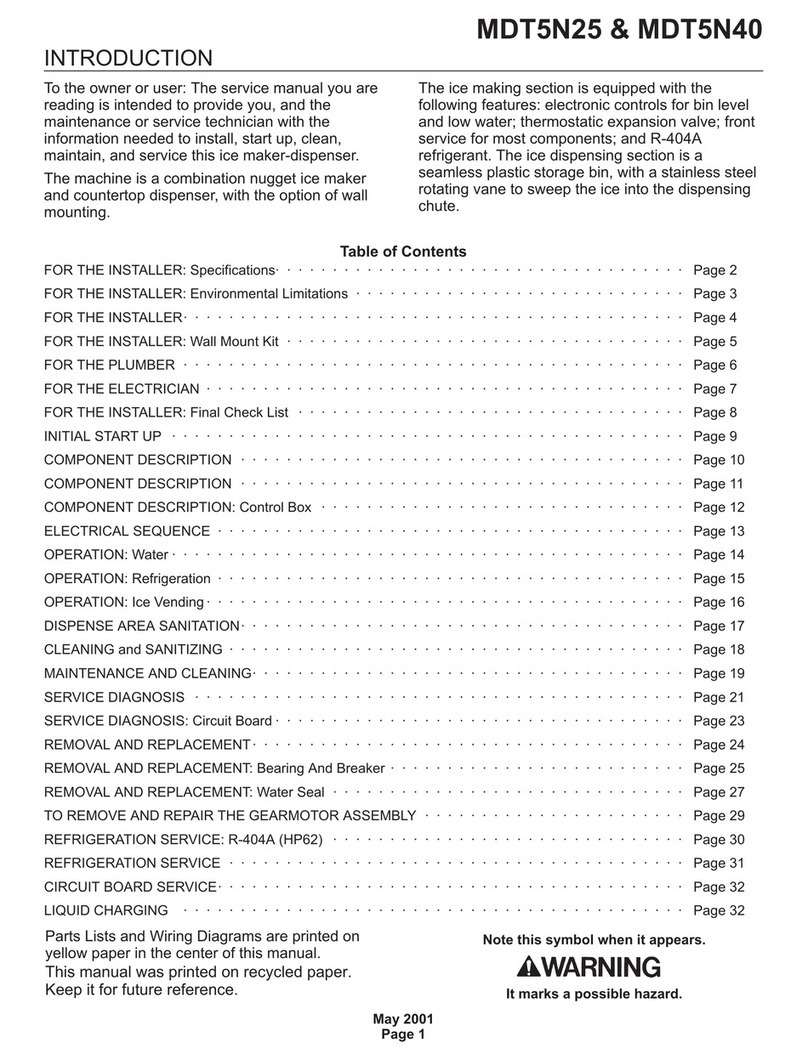
Scotsman
Scotsman TouchFree MDT5N40 Service manual
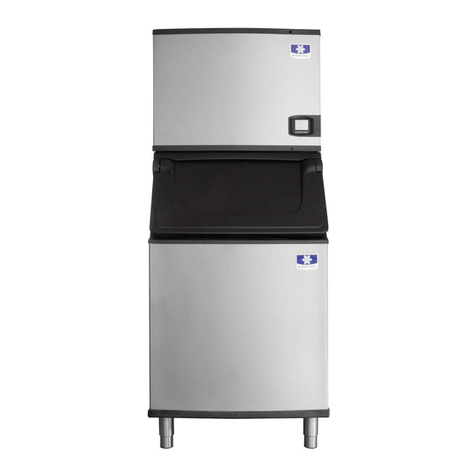
Manitowoc
Manitowoc Indigo NXT Installation, operation and maintenance manual
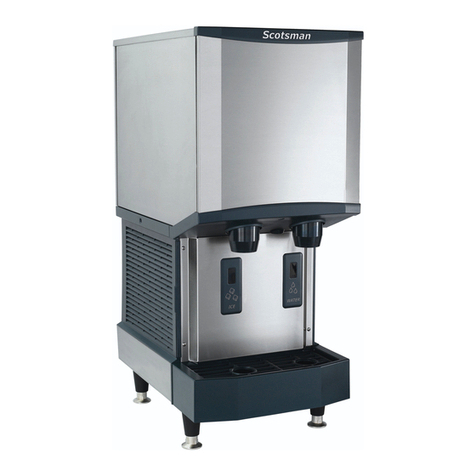
Scotsman
Scotsman HID312 user manual
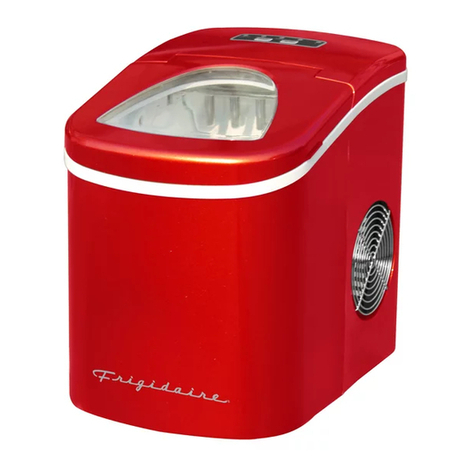
Frigidaire
Frigidaire EFIC113 user manual

Hoshizaki
Hoshizaki IM-200BAA instruction manual

Electrolux
Electrolux E15IM60GPS Installation guidelines
